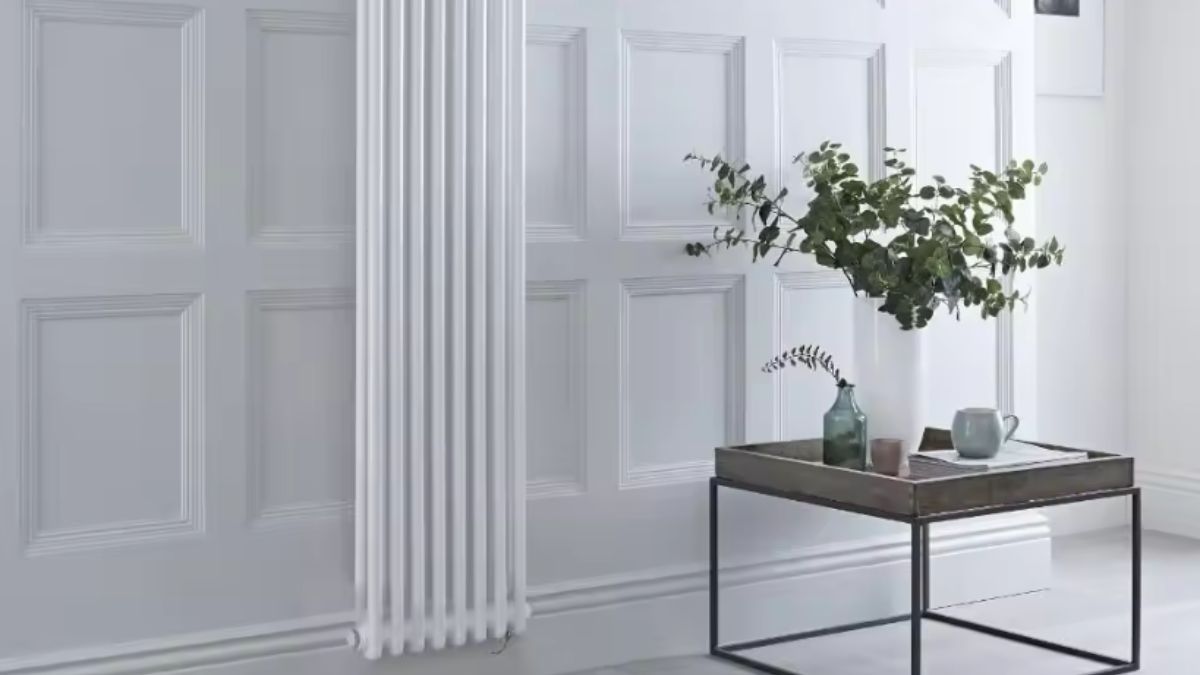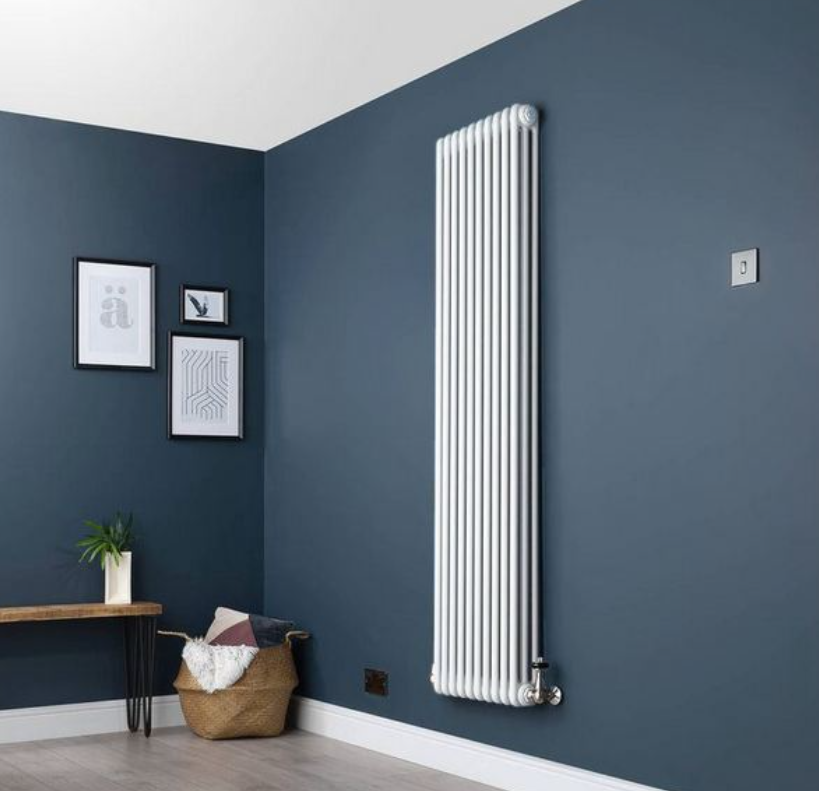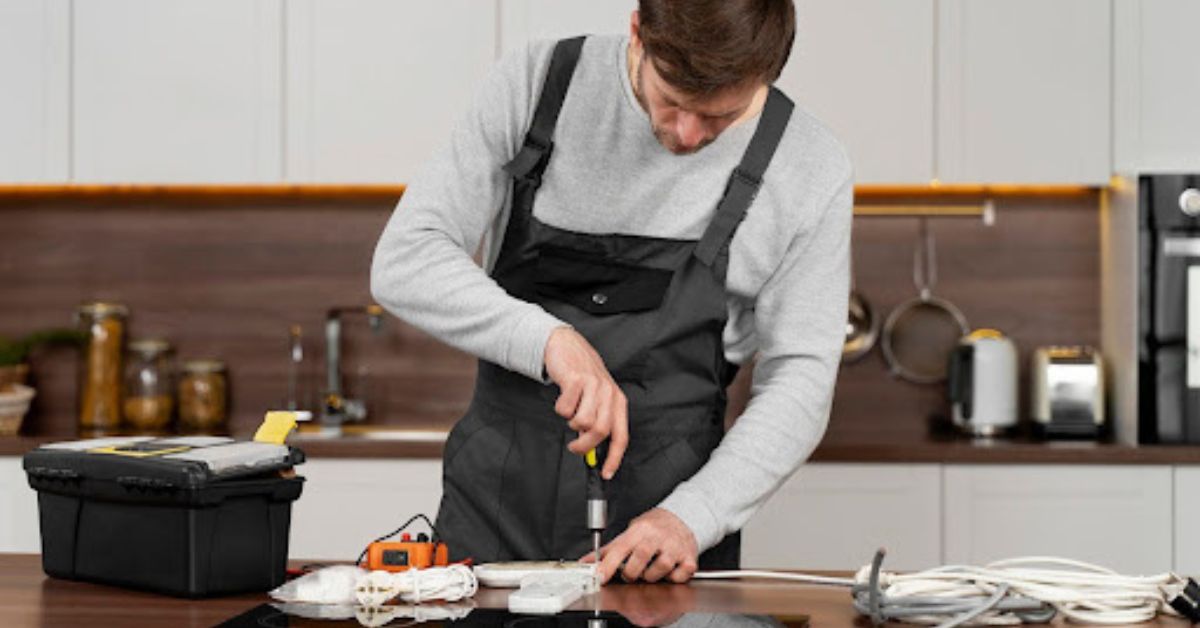HOME IMPROVEMENT
Why the Cornel Vertical 3-Column Radiator is a Perfect Space-Saving Heating Solution?

Traditional horizontal radiators can take up valuable wall space, making room layouts more challenging. This is where vertical radiators, such as the Cornel Vertical 3-Column Radiator (1800H x 519mm), come into play. These modern heating solutions offer powerful heat output while taking up minimal space, making them an excellent choice for contemporary homes and commercial settings.
In this guide, we’ll explore why the Cornel Vertical 3-Column Radiator is the perfect space-saving heating solution, covering its benefits, efficiency, and installation tips to help you make an informed decision.
The Cornel Vertical 3-Column Radiator is designed to deliver excellent heat performance while complementing modern and traditional interiors alike. With its tall, slim profile and sturdy three-column structure, it provides a combination of aesthetic appeal and functional efficiency.
Unlike standard horizontal radiators, which require a longer section of wall space, the vertical design of this radiator makes it ideal for rooms where floor space is limited. Whether you’re renovating a small apartment or designing an office, this heating solution ensures warmth without compromising on space.
Why Choose a Vertical Radiator?

If you’re considering upgrading your home heating system, you might be wondering why a vertical radiator is a better choice. Here are some compelling reasons:
- Maximizes Wall Space
One of the biggest advantages of vertical radiators is that they take up less horizontal space compared to traditional radiators. This makes them perfect for small rooms, hallways, and areas where space is limited. Instead of occupying an entire wall, the Cornel Vertical 3-Column Radiator stands tall and slim, allowing you to utilize more of your wall space for furniture or décor.
- High Heat Output
Despite its slim design, this radiator offers efficient heat distribution throughout the room. The three-column structure ensures that heat circulates evenly, keeping your space warm and comfortable. Whether you install it in a living room, bedroom, or office, you can count on consistent warmth without sacrificing aesthetics.
- Modern and Stylish Design
The Cornel Vertical 3-Column Radiator is not just about functionality—it also enhances the overall look of your space. Available in a variety of finishes, it complements both contemporary and traditional interiors. The sleek, upright design adds a touch of elegance, making it a standout feature in any room.
Where to Install the Cornel Vertical 3-Column Radiator?
Choosing the right location for your radiator is essential for maximizing heat efficiency. Here are some ideal placement options:
- Hallways and Entryways:Make the most of limited space while ensuring warmth in high-traffic areas.
- Living Rooms:Free up wall space for furniture while keeping the room cozy.
- Bedrooms:Maintain a stylish and clutter-free environment with a sleek, upright radiator.
- Bathrooms:A perfect addition to modern bathrooms where floor space is limited.
If you’re considering purchasing one for your home, now is the time to buy Cornel Vertical 3-Column Radiator and enjoy the benefits of space-efficient heating.
Energy Efficiency and Cost-Effectiveness
The Cornel Vertical 3-Column Radiator is designed with energy efficiency in mind. Here’s how it helps you save on heating costs:
- Fast Heating and Heat Retention
This radiator quickly reaches its optimal temperature and retains heat for an extended period, reducing the need for constant heating and lowering energy consumption.
- Compatible with Modern Heating Systems
It works seamlessly with central heating systems, ensuring maximum efficiency and performance.
- Reduced Wastage
With a vertical design, heat spreads more evenly across the room, eliminating cold spots and ensuring warmth is distributed efficiently.
Comparing Different Types of Column Radiators
Before making a purchase, it’s helpful to explore different types of Column Radiators to see how they compare to the Cornel model. Here are some variations:
- Horizontal Column Radiators
- Traditional design, ideal for under windows or along longer walls.
- Require more horizontal space compared to vertical models.
- Single-Column Radiators
- Slim and space-saving, but offer less heat output.
- Best for smaller rooms or supplementary heating.
- Double and Triple-Column Radiators
- Provide higher heat output than single-column models.
- Suitable for larger spaces needing consistent warmth.
Among these options, the Cornel Vertical 3-Column Radiator stands out due to its perfect balance of heat efficiency and space-saving design.
Installation Tips for Optimal Performance
Proper installation is key to ensuring that your vertical radiator functions efficiently. Here are some expert tips:
- Choose the Right Wall
Ensure the wall is sturdy enough to support the weight of the radiator. If mounting on drywall, use reinforced brackets for added security.
- Consider Pipework Adjustments
Since vertical radiators may require pipework modifications, consult a professional to ensure a seamless installation.
- Maintain Adequate Clearance
Leave some space around the radiator to allow for proper heat circulation. This prevents heat from getting trapped behind furniture or curtains.
- Use Thermostatic Valves
Installing thermostatic radiator valves (TRVs) helps regulate temperature, making your heating system more energy-efficient.
Last Words
The Cornel Vertical 3-Column Radiator is an excellent choice for homeowners and businesses looking for a stylish, space-saving, and energy-efficient heating solution. Its vertical design ensures maximum wall space utilization, while its three-column structure provides optimal heat output.
HOME IMPROVEMENT
Water-Efficient Lawns: Advanced Irrigation Techniques for Today’s Homes

Homeowners are increasingly seeking ways to maintain lush, green yards while conserving water and lowering utility costs. Traditional watering methods often lead to waste through runoff, evaporation, or overwatering, especially during hot or dry seasons. Adopting smarter watering habits that align with changing environmental needs is essential to keeping outdoor spaces healthy and sustainable.
Modern systems make it easier to achieve efficiency without sacrificing appearance. Tools like smart timers, drip lines, and moisture sensors transform water delivery. Lawn irrigation systems that adapt to weather and soil conditions help minimize waste and ensure that grass and plants receive the right amount of hydration. These solutions support responsible water use and reduce long-term maintenance efforts, making them ideal for today’s resource-conscious homeowners.
Smart Irrigation Controllers
Smart irrigation controllers are revolutionizing lawn care and water conservation by automatically adjusting watering routines based on real-time weather data, historic patterns, and soil conditions. These controllers monitor rainfall, evaporation, temperature, and humidity to tailor watering to specific lawn needs. They can be managed remotely through smartphone apps, allowing homeowners to change settings based on climate conditions or personal preferences. Switching to smart irrigation can reduce water consumption by up to 30%.
Drip Irrigation Systems
Modern homeowners increasingly use advanced irrigation methods to maintain healthy, water-efficient lawns without excessive waste. Systems like drip irrigation target plant roots directly, reducing evaporation and runoff while ensuring consistent moisture levels. These techniques are especially effective in areas with water restrictions or hot, dry climates. Integrating such methods into landscaping plans can enhance function and appearance, supporting sustainable yard care. Smart controllers and moisture sensors can optimize water use, adjusting output based on weather or soil conditions. These innovations promote healthier lawns and gardens while conserving a critical resource, aligning with environmentally responsible home practices.
Rain Sensors
Rain sensors are essential components of modern water-saving irrigation systems. They automatically shut off watering during and after rain, preventing overwatering and protecting plants from excessive moisture that can suffocate roots and promote weeds. In areas with unpredictable rainfall, rain sensors are a practical upgrade that quickly pays for itself through reduced water bills and healthier lawns. For homeowners looking to enhance water efficiency, rain sensors are a valuable solution that extends irrigation equipment’s life by ensuring it’s only used when necessary.
Soil Moisture Sensors
Soil moisture sensors are essential for optimized irrigation. They monitor soil water content, activating your irrigation system only when necessary. Setting moisture thresholds prevents overwatering, which wastes water and can harm plant roots. Installing sensors at various depths ensures all plants receive proper hydration.
These sensors save water and promote healthier root systems, encouraging deeper growth and making plants more drought-resistant and less disease-prone. Integrating them into your irrigation strategy is a simple but effective way to enhance eco-friendly lawn care.
High-Efficiency Sprinkler Heads
Upgrading to high-efficiency sprinkler heads is a simple yet impactful way to enhance your irrigation system. These modern devices use precision nozzles and advanced spray patterns to distribute water evenly, reducing runoff and waste. Unlike conventional sprinklers, which can lose water to wind or evaporation, high-efficiency heads provide reliable coverage.
They are particularly beneficial for lawns with unique shapes or landscaping challenges, preventing patchy areas and flooding. Compatible with most existing systems, these heads offer a cost-effective solution to improve the health and appearance of your outdoor space while lowering water bills.
HOME IMPROVEMENT
Saving Time and Money with Oven, Range & Stove Repair Pro

It was just another weeknight in Manhattan when Melissa realized her oven wasn’t heating properly. With her kids hungry and a half-cooked casserole waiting, she scrambled to find an appliance repair service near me. After a quick online search, she came across Oven, Range & Stove Repair Pro and called 646-980-6968. Within hours, a technician arrived and saved dinner along with her evening.
Like Melissa, many homeowners don’t realize how much time and money they can save by working with the best professional appliance repair service in their area. Let’s explore how Oven, Range & Stove Repair Pro can help you get your kitchen back in shape without the stress or high cost.
Early Repairs Prevent Expensive Replacements
A small issue in your stove, oven, or range can turn into a major breakdown if ignored. A burner that won’t light or an oven that heats unevenly might seem manageable, but over time, these small problems can damage the appliance’s core components.
By hiring a professional appliance repair company like Oven, Range & Stove Repair Pro, you can catch problems early and avoid the cost of a full replacement. Their team of expert appliance repair technicians knows how to detect minor faults before they become serious.
This proactive approach is what makes them one of the best appliance repair service providers in Manhattan.
Fast Service That Keeps Your Routine On Track
Busy schedules don’t allow for long delays, especially when essential appliances stop working. That’s why speedy appliance technicians are essential in today’s world.
With speedy appliance technicians near me dispatched the same day you call, Oven, Range & Stove Repair Pro minimizes downtime. Whether you’re dealing with a broken range or a faulty stovetop, their team works fast without sacrificing quality.
Looking for a local appliance repair team that responds quickly? Call 646-980-6968 and get your repair done right the first time.
Professional Technicians Deliver Long-Term Value
DIY videos and budget repairmen may seem like money-saving options, but poor workmanship often leads to more damage. That’s why investing in professional appliance technicians near me is actually more affordable in the long run.
Oven, Range & Stove Repair Pro provides trained and licensed professional appliance technicians who understand all brands and models. They arrive fully equipped and ready to fix problems the right way.
This dedication to quality makes them a standout appliance repair company among others in Manhattan.
Affordable Appliance Repair That Fits Your Budget
Cost is one of the biggest concerns for homeowners facing appliance issues. Luckily, Oven, Range & Stove Repair Pro is known as an affordable appliance repair company offering top-tier service without breaking the bank.
Their pricing is upfront and fair. As an affordable appliance repair service, they provide accurate estimates, avoid unnecessary upsells, and ensure every dollar is well spent.
So if you’re looking for the best local appliance repair without inflated prices, this is the team to trust.
Specialized Experts for Ovens, Ranges, and Stoves
Not all technicians are qualified to fix cooking appliances. You need a stove repair professional who understands safety, gas lines, electronics, and heating mechanisms.
Oven, Range & Stove Repair Pro employs the best oven repair professionals, range repair professionals, and stove repair professionals near me to ensure that no matter the issue, you get specialized help.
From poor heating and broken knobs to full ignition failure, their affordable range repair professionals are trained to handle it all. If your appliance is misbehaving, don’t wait, call 646-980-6968 for expert assistance.
Local Knowledge Matters in Manhattan
Finding a repair team that knows the area is more valuable than most homeowners realize. When you hire Oven, Range & Stove Repair Pro, you’re choosing a business that understands the common appliance brands, building codes, and customer expectations in Manhattan.
As a local appliance repair expert, they bring a personal touch, fast access, and proven results. They’re not just another business, they’re your neighbors, and they treat your appliances with the same care as their own.
Long-Term Peace of Mind with the Right Partner
Working with the wrong repair company can lead to repeat visits, incomplete fixes, or voided warranties. With Oven, Range & Stove Repair Pro, you’re partnering with a team that guarantees their work and takes responsibility for delivering lasting results.
Their reputation as the best expert appliance repair team in Manhattan is backed by five-star reviews, return customers, and a track record of excellence. They’re not only a service provider, they’re a solution.
Conclusion: Save More with the Right Repair Service
When your kitchen appliances start acting up, it’s tempting to put off repairs or look for the cheapest option. But when you choose Oven, Range & Stove Repair Pro, you’re investing in speed, quality, and long-term savings.
Their commitment to timely service, expert repairs, and affordable pricing makes them the best appliance repair service in Manhattan. Whether it’s a minor glitch or a major issue, don’t wait until it’s too late.
HOME IMPROVEMENT
Rug Cleaning in Singapore: 6 Mistakes That Ruin Your Rugs

Your beautiful rugs add warmth and personality to your home, but they also face unique challenges in Singapore’s tropical climate. Many homeowners make costly mistakes when caring for their rugs, often causing more damage than the original problem they were trying to solve. Understanding these common errors helps you protect your investment and maintain your rugs’ beauty for years to come.
Why Rug Care Matters More in Singapore
Singapore’s consistently high humidity levels create the perfect environment for mould, mildew, and dust mites to thrive in your rugs. With humidity averaging over 80% year-round, your rugs absorb moisture from the air constantly, making them vulnerable to problems that don’t affect rugs in drier climates. Professional rug cleaning in Singapore becomes essential when you consider how quickly these issues can develop in our tropical environment.
1. Over-Wetting Your Rugs During Cleaning
Water seems harmless enough, but using too much water when cleaning your rugs creates serious problems. Excessive moisture seeps deep into the rug fibres and padding, where it can remain trapped for days or even weeks. This trapped moisture becomes a breeding ground for mould and mildew, which can permanently damage your rug and create health hazards for your family. When cleaning spills, use a well-wrung cloth that doesn’t drip water onto your rug.
2. Scrubbing Stains Too Aggressively
When you discover a stain on your expensive rug, your first instinct might be to scrub it vigorously until it disappears. This approach actually drives the stain deeper into the fibres while damaging the delicate rug structure. Hard scrubbing can cause your rug to look worn and frayed, especially around the areas where you’ve been working on stains. Instead, blot stains gently with a clean cloth and appropriate cleaning solution.
3. Using the Wrong Cleaning Products
Different rug materials require specific cleaning approaches, and using the wrong products can cause permanent discolouration or damage. Wool rugs need different care than synthetic materials, and natural fibre rugs react differently to cleaning chemicals than machine-made options. Research cleaning products carefully before applying them to your rug, and always test any new product on a small, hidden area first.
4. Leaving Spills Untreated for Too Long
Singapore’s humid climate means that spills and stains set much faster than they would in drier environments. What might seem minor today can become a permanent stain within 24 hours when combined with our tropical humidity. Food spills, pet accidents, and drink spillages need immediate attention to prevent them from penetrating deep into your rug fibres, where they become nearly impossible to remove completely.
5. Over-Shampooing During Deep Cleaning
Using too much shampoo or failing to rinse thoroughly after cleaning creates residue buildup that attracts more dirt over time. This residue makes your rug look dull and can cause the fibres to break down prematurely. In Singapore’s humid climate, soap residue also provides additional moisture that encourages mould growth and creates musty odours that circulate throughout your home.
6. Relying Only on DIY Cleaning Methods
While regular vacuuming and spot cleaning help maintain your rugs, they cannot address the deep-seated dirt, allergens, and moisture that accumulate in Singapore’s climate. Professional cleaning reaches areas that home cleaning cannot access, removing dust mites, bacteria, and allergens that affect your family’s health. Most homeowners wait until their rugs look visibly dirty, but by then, significant damage may have already occurred.
Professional Solutions for Singapore’s Climate Challenges
When these mistakes feel overwhelming or when your rugs need deeper care than home methods can provide, professional services offer systematic solutions designed for Singapore’s specific challenges. Be Mitey Clean understands the unique requirements of rug cleaning in Singapore and uses specialised equipment that addresses both surface stains and deep-seated moisture issues that develop in our humid climate.
Their multi-step process includes pre-inspection to identify specific cleaning needs, dust mite removal systems that target allergens, and controlled moisture extraction that prevents over-wetting problems. The company’s experience with Singapore’s tropical conditions means they understand how to clean rugs thoroughly while ensuring proper drying to prevent mould and mildew development.
Protecting Your Investment
Your rugs represent significant investments in your home’s comfort and style, and protecting them from these common mistakes ensures they continue serving your family for years to come. Regular professional rug cleaning service in Singapore, combined with proper home maintenance, addresses the unique challenges our climate presents while preserving your rugs’ beauty and extending their lifespan.
Understanding these mistakes helps you make informed decisions about rug care and recognise when professional intervention can save you from costly replacement expenses. Your rugs deserve protection from Singapore’s challenging climate, and avoiding these common errors is the first step toward maintaining their value and appearance.
-

 TECHNOLOGY2 years ago
TECHNOLOGY2 years agoElevating Game Day Eats: A Guide to Crafting Crowd-Pleasing Sliders
-

 ENTERTAINMENT2 years ago
ENTERTAINMENT2 years agowave_of_happy_: Your Ultimate Guide
-

 FASHION2 years ago
FASHION2 years agoGPMsign Fashion: Redefining Style with Purpose
-

 TECHNOLOGY1 year ago
TECHNOLOGY1 year agoTrader Joe’s Dayforce: Revolutionizing Workforce Management
-

 FOOD2 years ago
FOOD2 years agoAltador Cup Food Court Background: A Culinary Extravaganza Unveiled
-

 SPORTS2 years ago
SPORTS2 years agoScore Chaser Sporting Clays: A Thrilling Pursuit of Precision
-

 HOME IMPROVEMENT1 year ago
HOME IMPROVEMENT1 year agoWhat Kitchen Renovation Companies Offer Beyond Basic Remodeling
-

 NEWS2 years ago
NEWS2 years agoNyl2 Kemono: Unveiling the World
